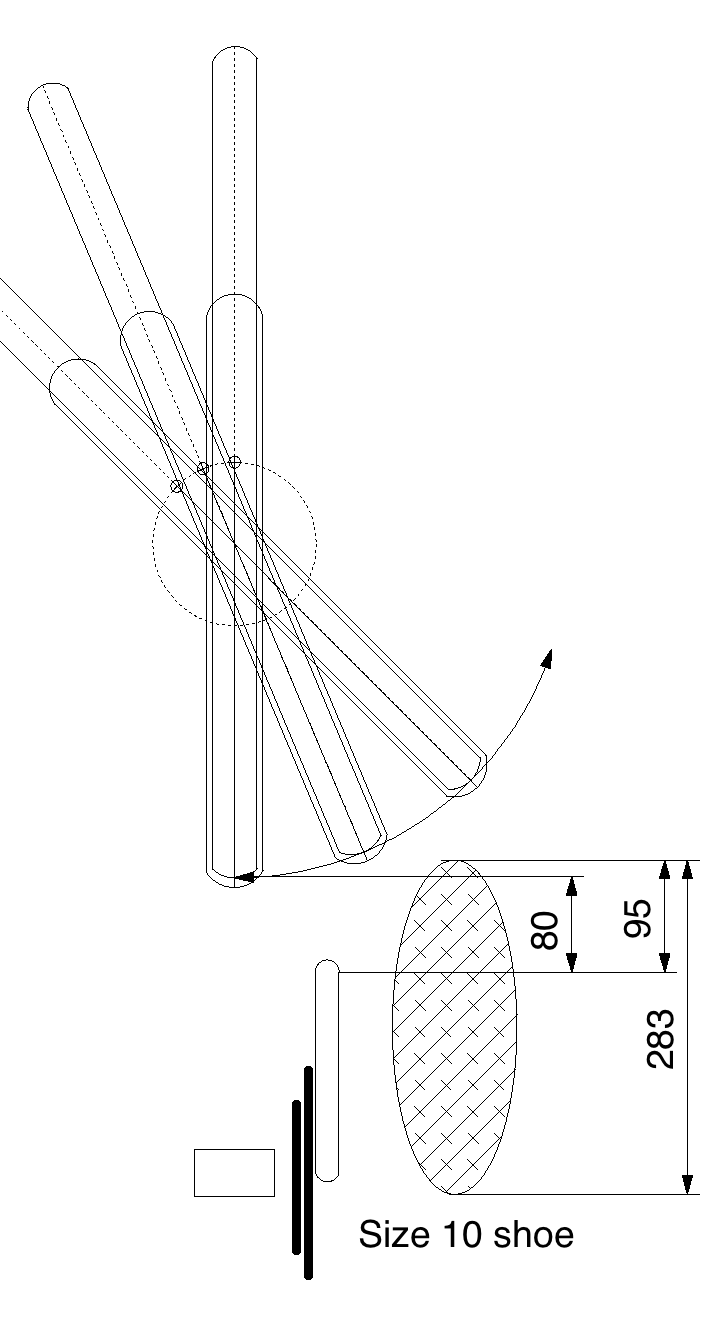
Toe Overlap With Wide Tires
Trail Mix for Gravel Bikes
I wrote this article to explain why we had to develop our own Rodriguez light weight disc fork.
OK, if you're here it's because you want to know more about bicycle design than a lot of professional bicycle designers. Designing a bicycle or a fork that will fit wide tires and fenders seems easy enough, but it's not. Designing for these criteria, while retaining desired handling characteristics, comfortable fit, and maintaining safety is something that baffles a lot folks (even in our industry). The key to any good design here starts with the fork. If you can grasp this relationship, you'll appreciate the Rodriguez approach to these details.
I find myself in the position of explaining this relationship on a daily basis. Customers often desire a specific fork (or other part) that may not work well for their intended use or bicycle size. Whether it's a new hair style, wheel size, or bike part, advertising has a way of creating strong consumer desire for something new without educating the consumer on the other challenges faced in using that design. I aim to provide that information so consumers can make an informed decision. The relationship between handling, rake, trail, toe clearance and wheel size is a difficult concept to explain, but I'll illustrate the challenges faced by bicycle designers in 2019.
First, there are a few terms that you will need to be acquainted with. These 5 things all play together to determine how your bike will handle as well and if you'll have room for big tires, fenders and feet.
- Wheel/tire diameter - In the industry, we call it wheel size, but we should call it tire diameter. The overall diameter of the wheel/tire varies depending on the width of tire installed. This affects bicycle design quite a bit more than you might think.
- Toe Clearance (Overlap) – Will your foot interfere when turning the front wheel with its tire installed. There are different minimums for different frame sizes. This number increases by 10mm if fenders will be used on the bike. Rule of thumb - More toe clearance is always better. This is measured from the center of the pedal spindle to the outside of the tire.
- Trail – The distance that the axle trails the steering axis intersection with the ground. A bigger number makes the the bike steer slower. Imaging slow handling is like a semi-truck, and quick handling like an MGB. Most people like the handling of a mid sized sedan. For most road riding, 60mm is ideal (our mid sized sedan).
- Fork Rake – Offset that places the fork ends ahead of the steering axis. More rake will make the steering quicker, but is not the only determining factor.
- Head Tube Angle – The angle that the frame holds the fork in relation to the ground (also called steering angle). Steepening the head angle will bring the wheel closer to the rider, slackening it will move it away. Head tube angle by itself does not determine how a bike will handle. The trail number is the determining factor.
The Issue
As people have asked for wider and wider tires with fenders (especially unforgiving metal fenders) the design parameters for the frame and fork had to change or people would have dangerous amounts of toe overlap. Forks of the past have generally been designed with 40mm to 45mm of rake. Ideal trail for most road riding is 60mm. That's the number that we shoot for.
Time for a few illustrations:
For our examples, I will use a 56cm frame design with the appropriate top tube length for drop (road) handle bars. Minimum toe clearance of 80mm is required for this size, assuming the addition of fenders in the future as a possibility. Let's also assume that this customer has a specific carbon fork in mind that he would like to use.
Note 80mm is minimum toe clearance for a bicycle this size that will be using fenders: Although it may look like the rider would hit their toe if they turned the wheel, because of the steering axis, the wheel moves outward during a turn and would have just enough clearance to use a fender and just miss their toe. Anything less than 80mm, and it hits.
The illustration to the right (or below on a phone) shows what I'm talking about. Click on it to see if full size.
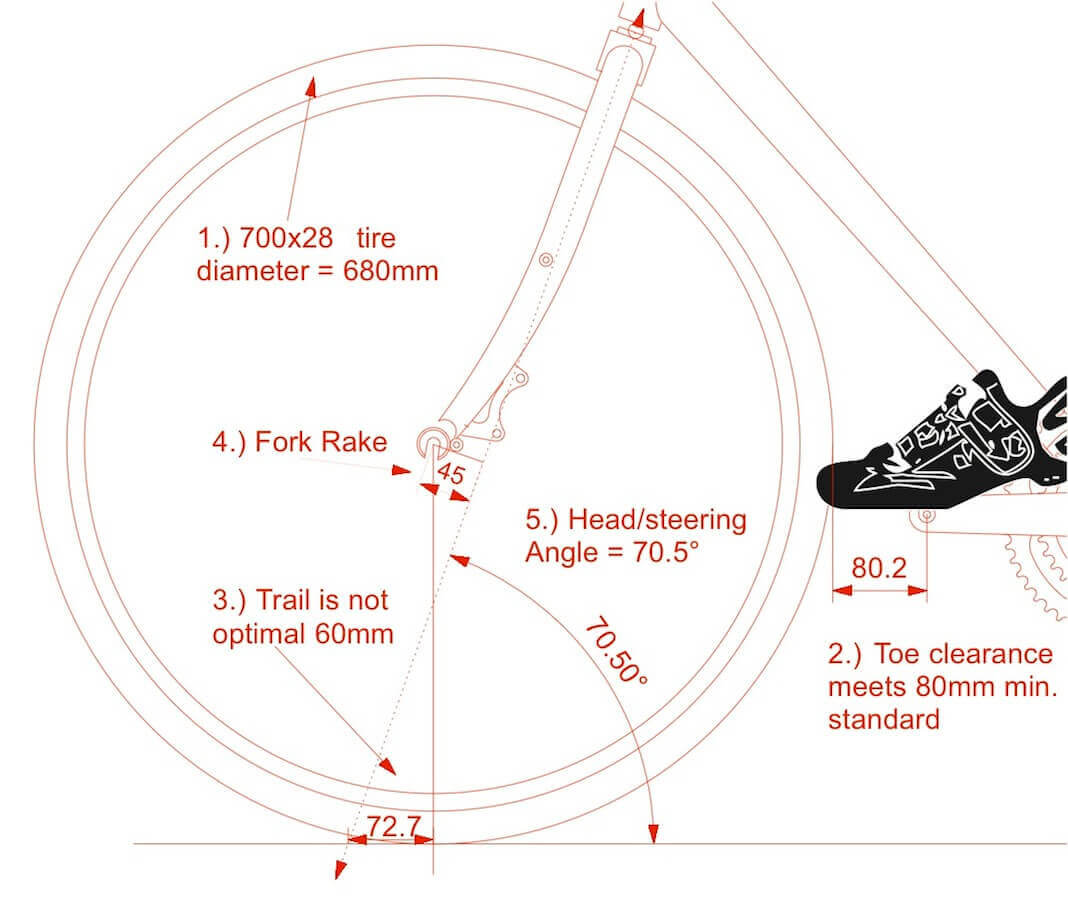
Example 1a: shows a standard 700c x 28mm tire/wheel combination with 45mm of fork rake and a head angle of 70.5°. This is a very common set up on modern 700c bikes as production carbon gravel forks are only available in 45~47mm rake. The 45mm rake would require a head angle steeper than 70.5° in order to set the trail to 60mm, but in this design, toe clearance requires that we sacrifice trail for safety and slacken the head angle to move the wheel out. The smaller the frame, the more sacrifice there has to be.
Problems:
- Trail number is 72.7 (not ideal of 60mm)
- Toe clearance just meets minimun acceptable clearance of 80mm. If rider wants to run wider tires than 28mm with fenders, they will have toe overlap.
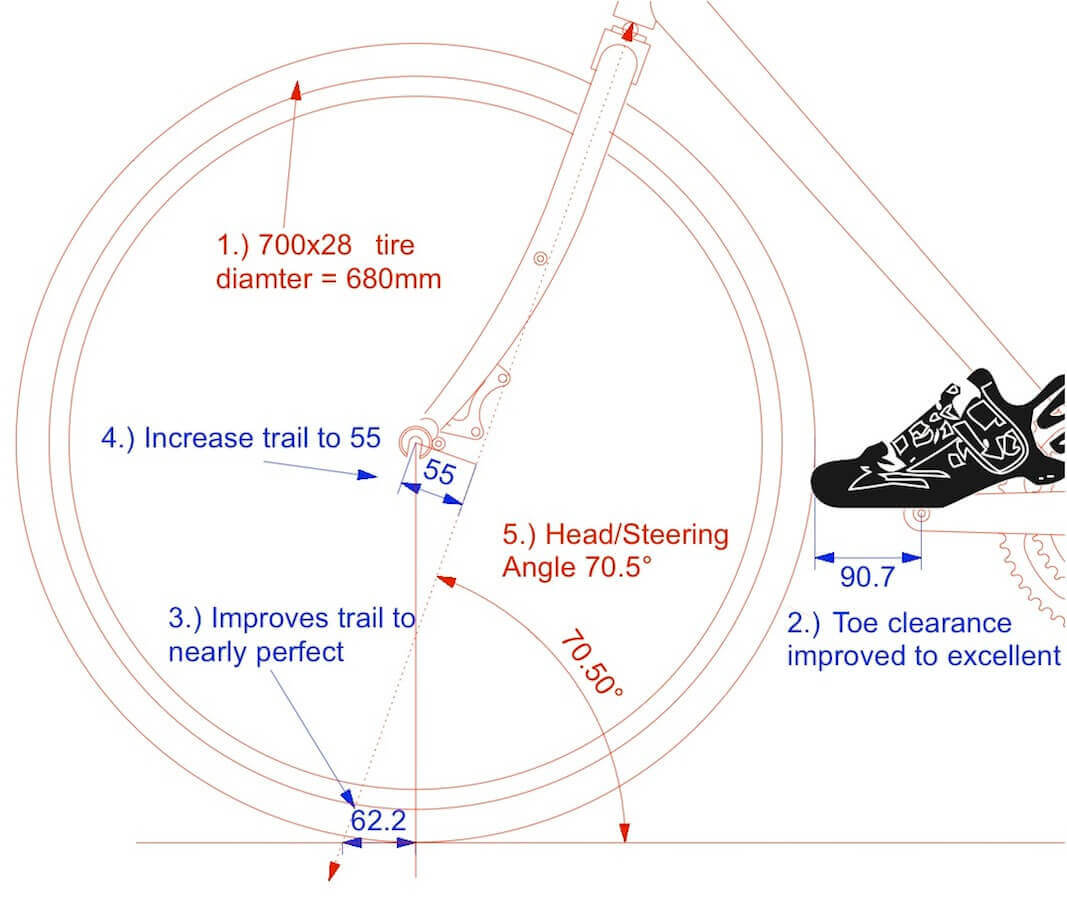
Example 1b: shows what should be an easy fix for the problems being faced. We simply increase the fork rake to 55mm and viola! The trail number drops to an excellent 61mm, and the toe overlap decreases to a very acceptable 90mm. This is why we developed our own Phinney Ridge light weight fork.
Note that increasing fork rake will always lower the trail number and quicken the steering of a bike. It will also move the wheel forward, away from the rider.
Problem:
Almost all of the light weight forks on the market only have 45mm to 47mm rake. Even if they have clearance for wide tires and fenders, the geometry does not work out for desired handling.
Now To 2019
In 2019, a 28mm tire is considered narrow (never thought I'd hear that). So, let's examine what happens when we design the same bike for a 700 x 38mm tire. What do we have to do to fit these wider (and taller) tires into the bike design and retain handling, toe clearance, and fit? Lengthening the top tube will mess up the rider's reach to the handle bars, so that's out. Keep in mind: increasing the tire diameter will always increase the trail slighty on a bicycle. The industry hasn't yet caught up with this trend and increased rake on their carbon forks. Since we cannot change the fork rake on a carbon fork, to make room for the bigger tires, a designer has to slacken the head angle. This will move the wheel out to make the toe clearance, but also increase the trail substantially. The bike will steer slow with a high trail number. A better solution is to increase the fork rake and lower the trail, but with modern light weight forks this is not possible. This is the reason the we felt we needed to design our own light weight fork.
Let's have a look at what a designer has to do.
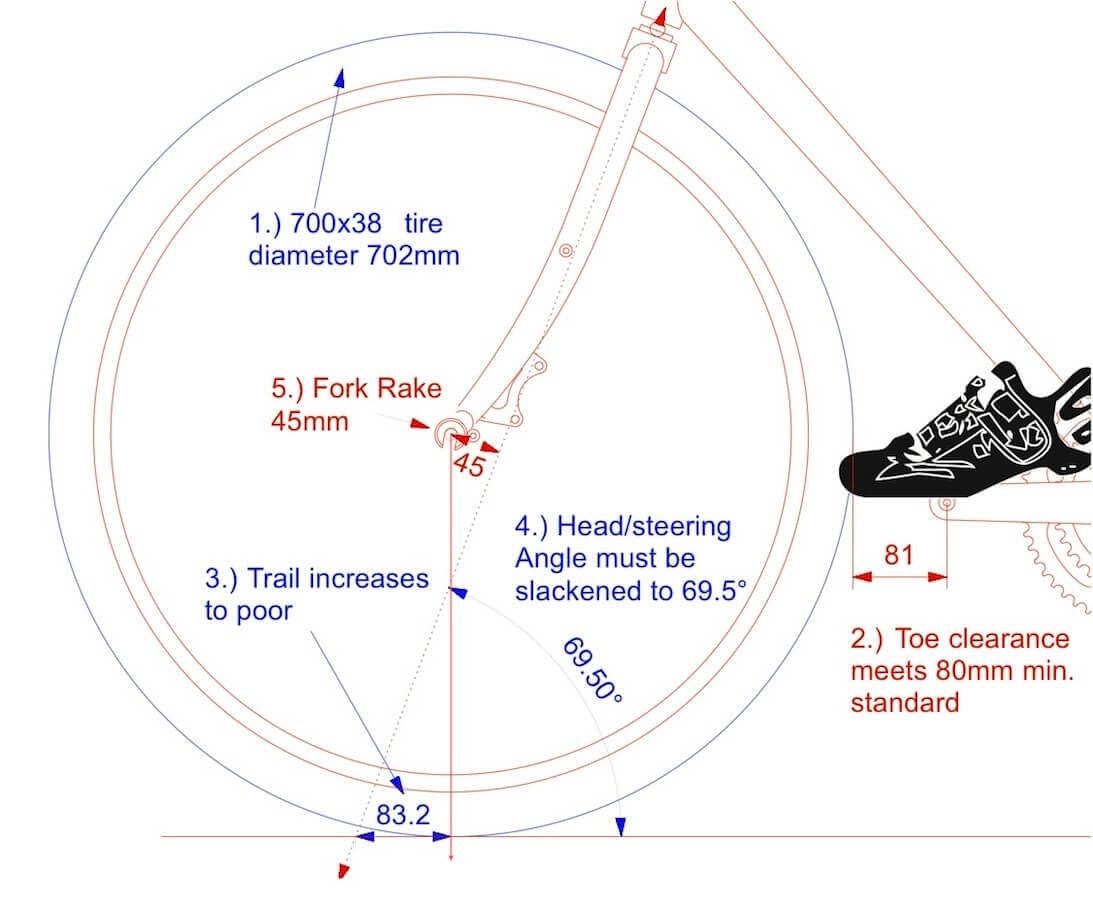
Example 2a: shows a 700c x 38mm tire/wheel combination with 45mm of fork rake. What manufactures do to make this work is 'slacken' the head/steering angle. This will move the wheel away from the bike and leave the fit the same, but it will make the steering slow. This is very common on gravel bikes in many lines. Without the ability to increase the rake of the fork, the only option they have is this on bikes this size and smaller. The smaller the frame, the slacker the head angle has to be.
Problems:
- Trail number increased to 83mm (slow handling)
- Toe clearance meets minimun acceptable clearance of 80mm, but at a cost of handling.
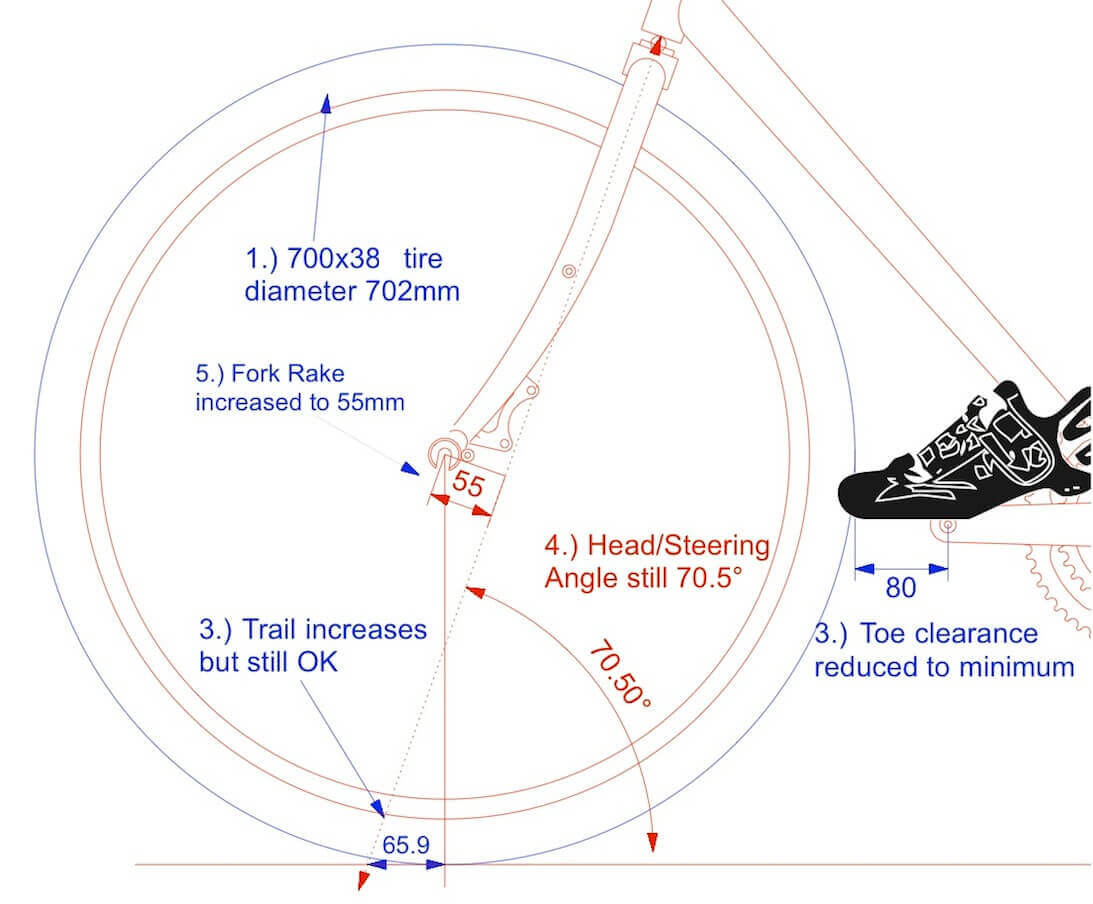
Example 2b: shows the same set up with our Phinney Ridge light weight disc fork installed. The 55mm rake allows us to retain excellent handling characteristics, fit, and still have the minimum toe clearance of 80mm. In fact, we didn't have to change anything about the design except install the wider tires.
Problem:
The same problem as before: The industry has not caught up with this trend of really wide tires with fenders. They are still making and advertising 'gravel bike' forks with insufficient rake for the toe clearance and handling requirements.
Enter the Smaller Wheel
So what do we do for bikes smaller than this 56cm (medium) frame size? Well, for almost 50 years now, we've been advocating smaller wheels for smaller frame sizes. Until recently, it was a tough sell, and many in the industry mocked us and said things like "smaller wheels are slower". The acceptance of the 650b (or 27.5") wheel size finally makes the smaller wheel cool. Now it's no problem to recommend to someone a smaller wheel for a better performing bike. Let's examine the same bike designed for 650b wheels with 38mm tires and see how a smaller wheel can improve the handling and increase toe clearance, even with a 45mm rake in the fork.
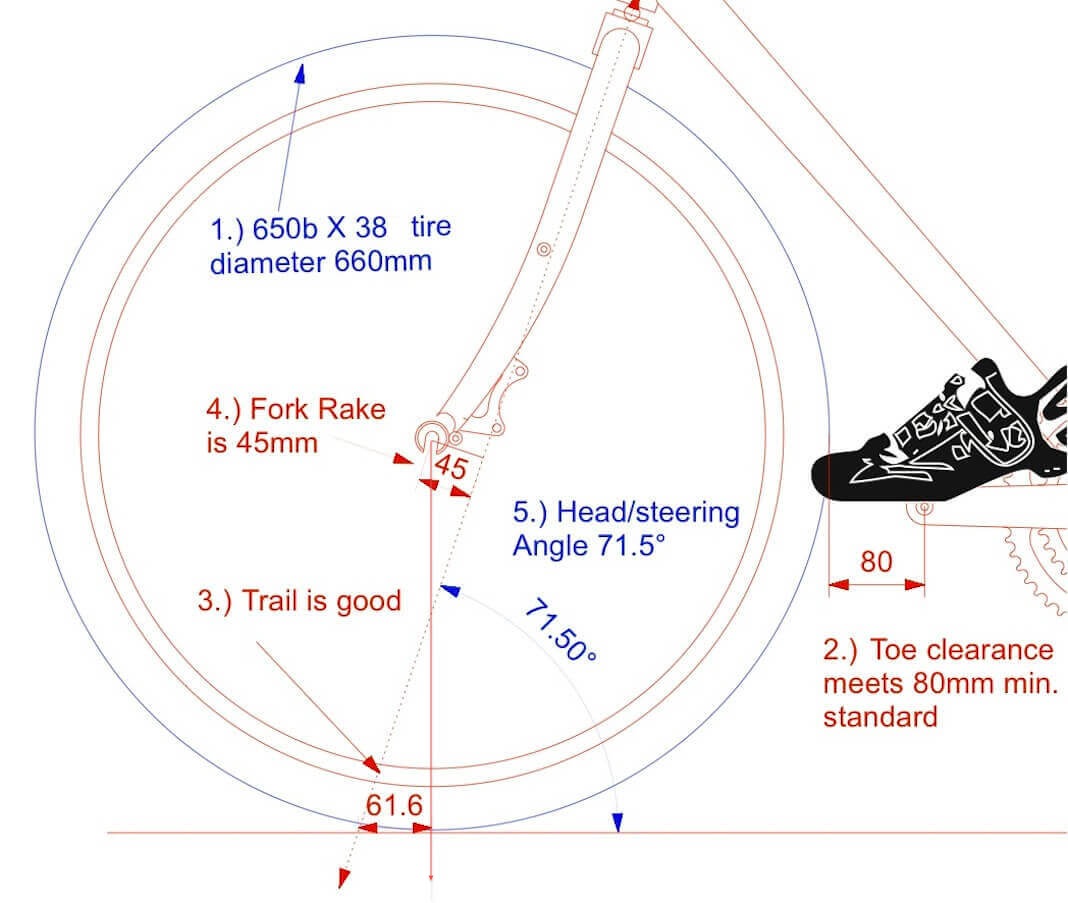
Example 3a: shows a 650b x 38mm tire/wheel combination with 45mm of fork rake. A smaller diameter wheel will always lower the trail number and increase toe clearance. In this case the smaller wheel even allows us to steepen the head angle a bit, and lower the trail while still maintaining acceptable toe clearance. This combination performs quite well unless the rider wants to use even wider (taller) tires.
Problems:
- Maximum safe tire width with fender is 38mm
- In 2019, many people want the option to run up to 54mm tires
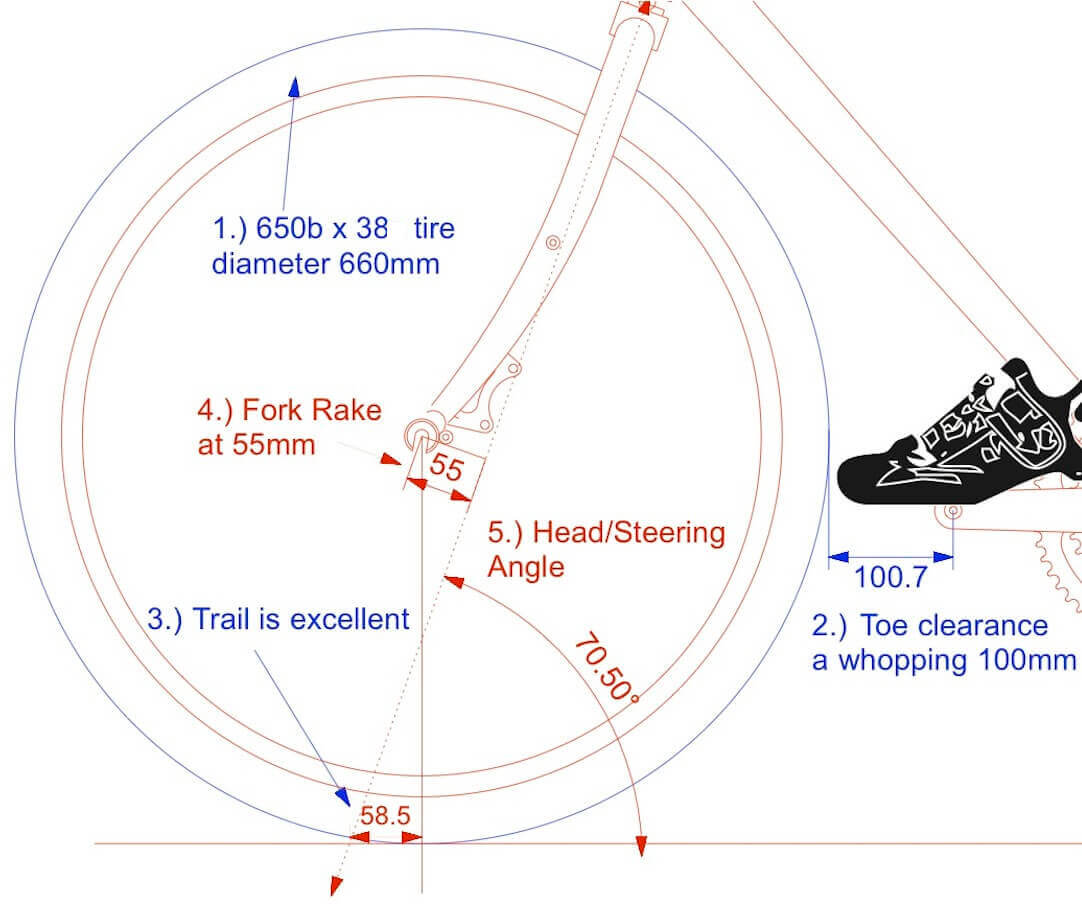
Example 3b: shows the same set up with our Phinney Ridge light weight disc fork installed. Now we can leave the head angle at 70.5°. As you can see, we end up with excellent trail of 58.5mm, and much more toe clearance. This will allow us to install even bigger tires without creating toe overlap.
Problem:
Even with the smaller wheel, the fork needs to have 55mm of rake for the desired steering. Again, the industry is still stuck in the 45~47mm rake of the past and therefore most light weight forks will not serve the customers needs properly.
Now for Really Wide Tires
Let's say that our customer wants to run this bike as a gravel bike with 2.125" (54mm) tires. They also want to be able to run fenders with these tires so our 80mm toe clearance minimum still stands. This is quite common in 2019. Remember, wider tires result in a larger diameter wheel, so handling and toe clearance need to be taken into consideration during the design process.
These numbers will look familiar to you. A 650b X 54mm tire is almost the same diameter as a 700c x 38mm tire. So the same compromises must be made.
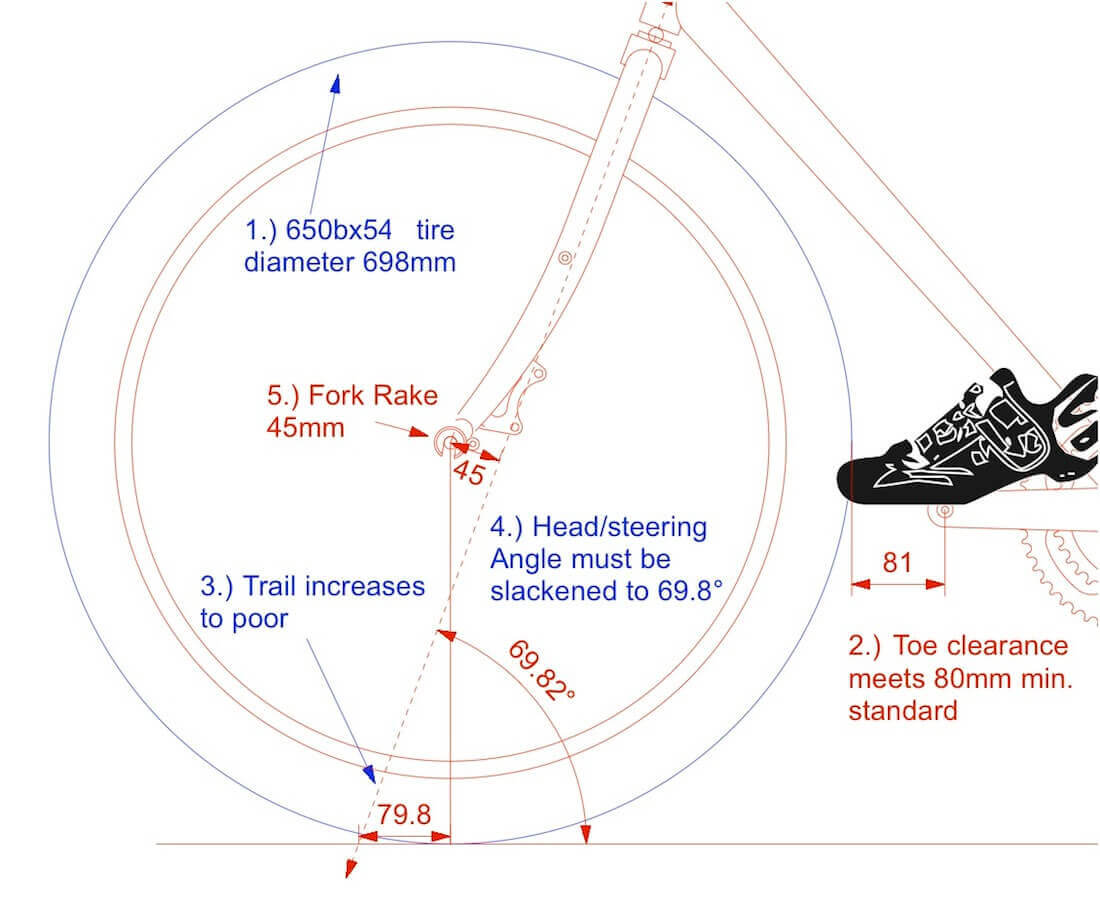
Example 4a: shows a 650b x 54mm tire/wheel combination with 45mm of fork rake. The wider tires result in a wheel diameter almost as big as the 700 x 38mm tire. The head angle has to be slackened to make the min. toe clearance at the cost of the trail. This bike will steer much slower.
Problem:
- High trail number resulting in slower steering than customer desires
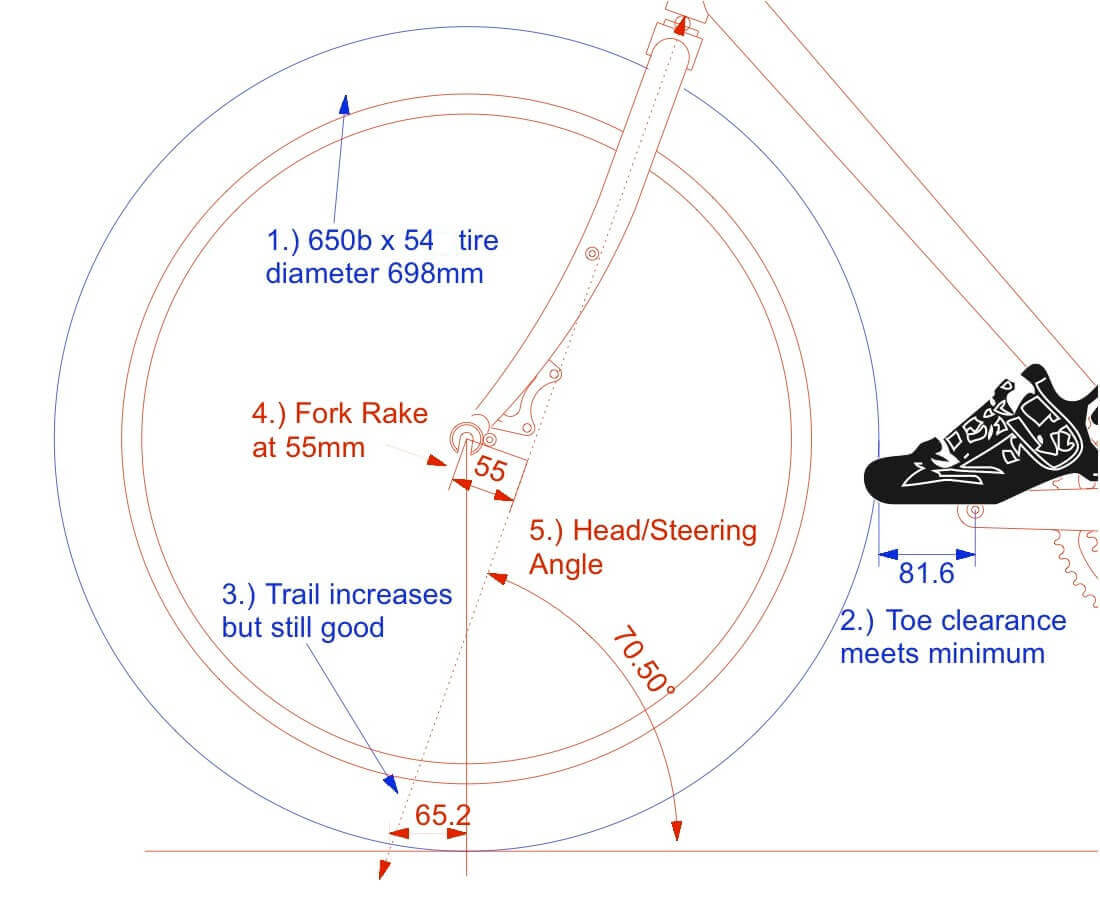
Example 4b: shows the same set up with our Phinney Ridge light weight disc fork installed. Now we can leave the head angle at 70.5°. With no change at all from the narrower tires, this bike will handle responsively, and provide plenty of toe clearance.
Problem:
You can see the theme here. The lack of light weight forks with adequate amounts of trail mean that either we use our new fork, or the bicycle handles like a semi-truck.
One More Thing to Consider
For the customer who wants really wide tires and fits a 56cm frame or smaller, there is another wheel size that should be considered. We use 26" wheels all the time on bikes like these, and always have. 26" is the most common size of wheel on the planet, and a gravel bike that runs really wide tires with fenders can be designed for better performance with this size. Let's take just a quick look at the design below. Notice that 26" x 54mm is actually a larger wheel diameter than 650b x 38mm.
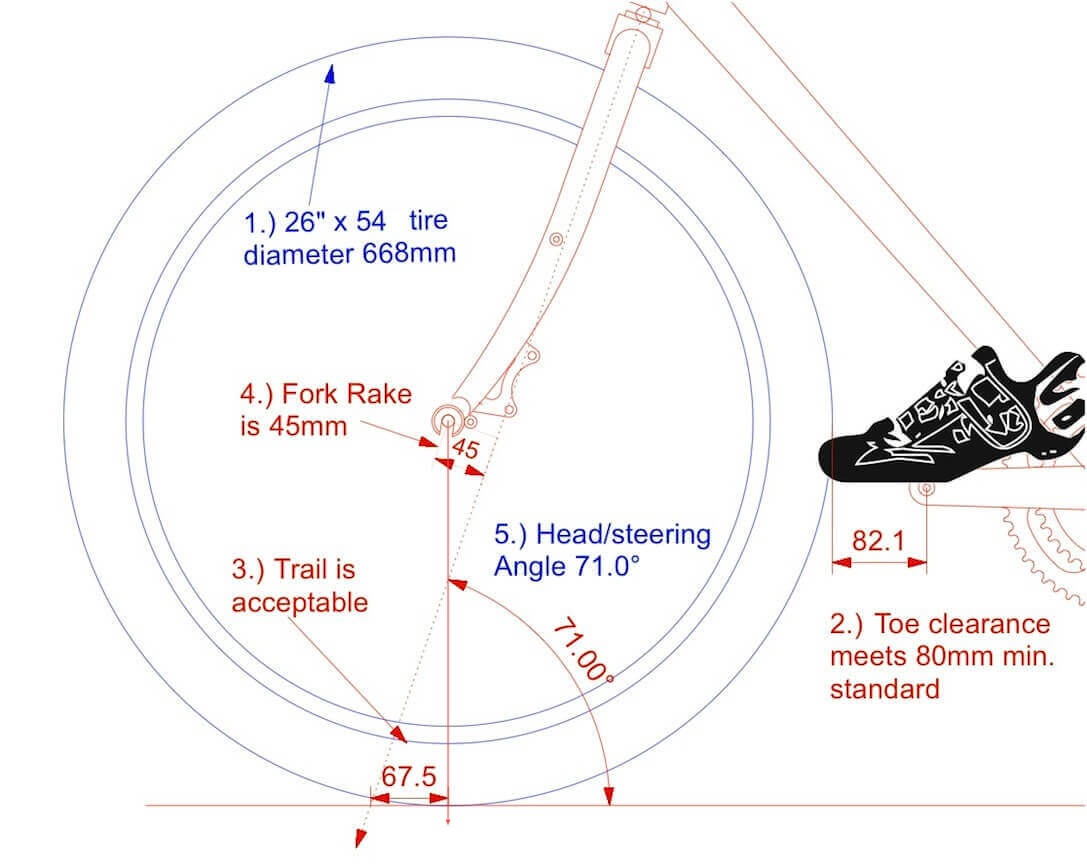
Example 5a: shows a 26" x 54mm tire/wheel combination with a carbon fork that has 45mm of fork rake. The head angle has to be slackened just a hair for the min. toe clearance, but the trail number is still quite acceptable. This bike will handle well, and the rider will have toe clearance. For a smaller frame size, we would want more fork rake or handling will suffer.
Problem:
- For a smaller frame size, the handling would have to be sacrificed for toe clearance
- While 26" wheel size has fallen out of favor among some in the industry, If tires continue to get wider, I predict a quick comeback.
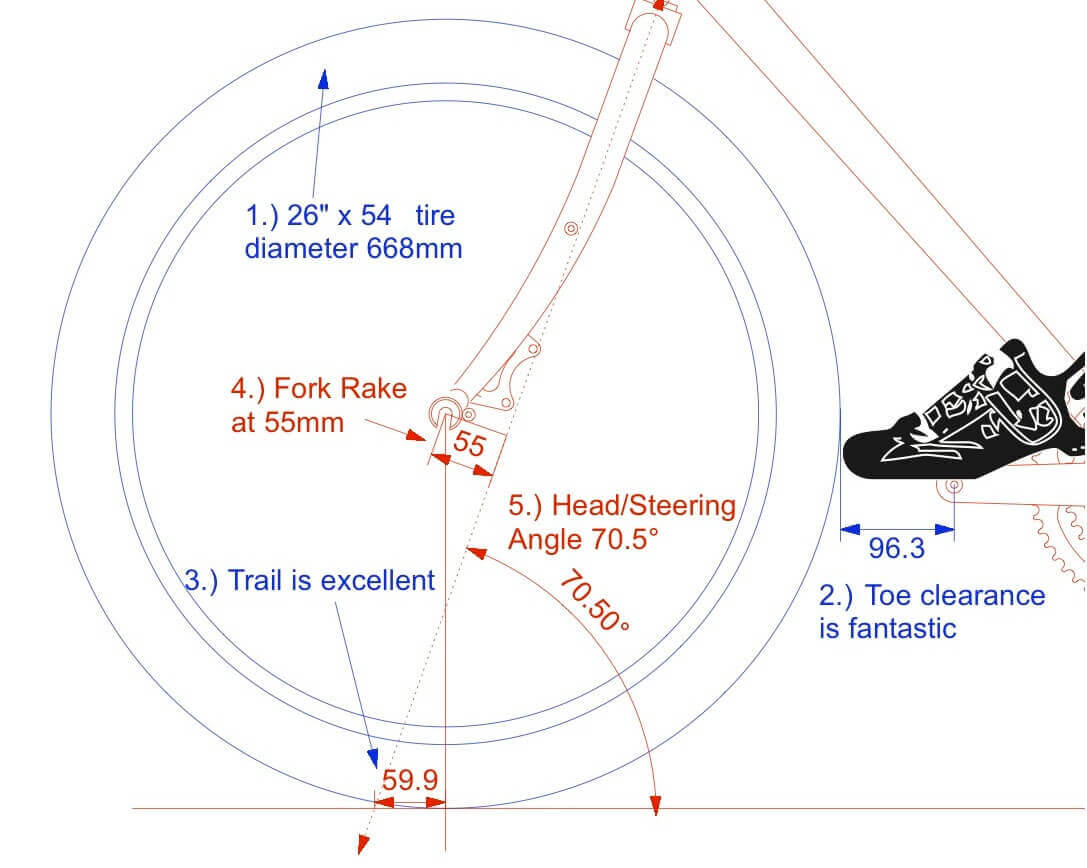
Example 5b: shows the same set up with our Phinney Ridge light weight disc fork installed. Notice the perfect trail numbers and ample toe clearance. This bike will handle beautifully, and the customer could even run wider tires if they wanted to. This size works very well for people who ride smaller frame sizes than 56cm as well.
Problems:
- Forks with 55mm of rake that have fender and rack mounts, as well as lots of tire and fender clearance are hard to come by.
- While 26" wheel size has fallen out of favor among some in the industry, If tires continue to get wider, I predict a quick comeback.
Conclusion
Wow! Are you still here? That's a lot of info to absorb...isn't it? I hope that this article has helped some to understand the challenges that face bicycle designers with the ever changing state of parts availability, designs, and desires on our customers part. We aim to please (and educate when possible), and that leads us to develop products like our Phinney Ridge light weight fork in order to give Rodriguez customers the performance that they've come to expect from our bikes.
Thanks for reading
Dan - June, 2019
Related Articles
- What bicycle wheel size is best - 2019
- Bicycle speed records and their wheel sizes - 2018
- Trail Mix for the Petite Cyclist - 2014
- The effect of wheel size on speed - 2004
- 650c vs. 700c wheels - 2012

